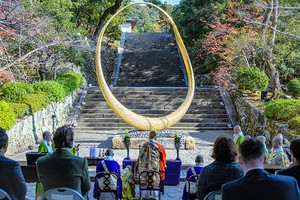By TATSURO SAKATA/ Staff Writer
December 19, 2022 at 07:10 JST
YAMAGATA--Researchers here have discovered 168 more ancient geoglyphs, where lines drawn across stretches of earth form images that can be seen from overhead, in Nazca, Peru.
The team from Yamagata University said the images of humans, camels, birds, killer whales, cats, snakes and other animals were likely created around 100 B.C.–A.D. 300.
The researchers, headed by Masato Sakai, a professor specializing in cultural anthropology and Andean archaeology, found the geoglyphs through surveys done from June 2019 to February 2020, the university said Nov. 8.
In the previous period covering more than a decade, the research team confirmed 190 geoglyphs in the area.
The new geoglyphs were found on the Nazca plateau stretching 20 kilometers east to west and 15 km north to south, and in the Aja area near urban Nazca about 20 km away from the plateau.
“We think this place close to the urban area, where geoglyphs are concentrated, was a place of importance,” Sakai said.

While the large ones extend more than 50 meters, many are only about 10 meters long or even smaller.
The university started its research on the Nazca Lines, one of the world’s most famous geoglyph sites, in 2004.
The research team is the only group that has obtained permission from Peru’s culture ministry to investigate the UNESCO World Heritage site designated in 1994.
Before that, only about 30 geoglyphs had been discovered in the region.
The team began on-site investigations in 2010 and founded the Yamagata University Institute of Nazca in the city of Nazca in 2012.
Of the 168 newly discovered images, 36 were found on a slope in the Aja area.
After 41 designs were uncovered in the area in 2013 and 2014, a ruins park was established there in 2017 to preserve the geoglyphs.

Still, a mine-related worksite is located nearby as well as a sprawling residential area.
“Geoglyphs are in danger of being destroyed,” Sakai said. “We want to clean the park so that the 77 images can be seen in one glance, and build momentum among local people for preservation.”
The geoglyphs were created by removing black stones covering the ground and exposing the white sand beneath.
They fall into two types: those created by removing stones to form lines and others to make surfaces.
Almost all of the newly discovered geoglyphs, or 163, had been created by removing stones to make surfaces.
The number of geoglyph discoveries sharply increased after the researchers began a full-scale introduction of drones for investigations in 2019.
The fact that an increasing number of geoglyphs are being discovered has given researchers new clues about the purpose of the mysterious Nazca Lines.

“We look at writings to study and share knowledge,” Sakai said. “It is possible that people in a preliterate society tried to communicate with geoglyphs and their distribution.”
He said the team now intends to look for patterns in the geoglyphs by studying their distribution.
The team is also working on analysis of images accumulated through on-site investigations with the help of artificial intelligence (AI).
AI technology shows designs that are likely to be geoglyphs. The team checks in Nazca whether they are actually geoglyphs.




















A peek through the music industry’s curtain at the producers who harnessed social media to help their idols go global.
A series based on diplomatic documents declassified by Japan’s Foreign Ministry
Here is a collection of first-hand accounts by “hibakusha” atomic bomb survivors.
Cooking experts, chefs and others involved in the field of food introduce their special recipes intertwined with their paths in life.
A series about Japanese-Americans and their memories of World War II